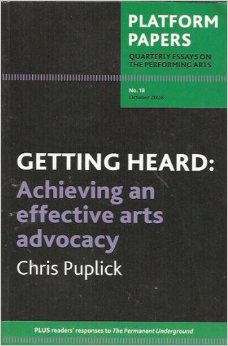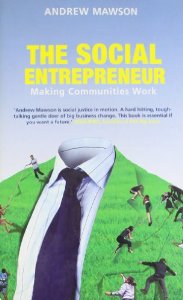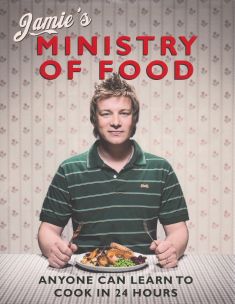TURNING OLD SONGS INTO A NEW CHORUS
by
Paul Bentley
Article
originally published in Museum Matters December 2008 and reprinted with kind permission of the
publishers Museums Australia Inc NSW.
Advocacy is a thing that professional
associations are expected to do. But what is it that organisations like
Museums Australia need to advocate and how do they do it? Recent talks, books
and TV cooking shows suggest some of the answers.
Influences
 |
At Museums Australia’s September forum, organised
to assist in developing a national policy for Australian museums, ACT branch
vice-president, Alex Marsden, was asked to comment as a result of her
work on the Australia 2020 Summit within the Department of the Prime Minister and
Cabinet. She said it was important to respond to opportunities that arise from
current government policies as flagged on the websites of the Council of
Australian Governments (www.coag.gov.au/), the 2020 Summit, (www.australia2020.gov.au/),
the Cultural Ministers Council (www.cmc.gov.au/) and other relevant
sites. Don’t place all your expectations on one or two ministers: they don’t
necessarily hold sway over their cabinets. Museum advocates need to cast their
messages more widely.
Chris Puplick has walked both sides of the fence as an government
minister and as a board member of several cultural organisations. In his
essay, Getting Heard: Achieving an Effective Arts Advocacy (Currency
House, Platform Papers no 18, October 2008), he made several suggestions.
First, look in the right places for support. Advocacy, he says,
requires inside knowledge and reliable connections. Although public inquiries
involve extensive public input, they are usually driven by a rare breed of
politician and they rely on the personal support of senior political leaders,
prominent and well-connected business leaders, or senior bureaucrats with
sympathetic interests.
Use the right language. Puplick says, in relation to the arts, that the
rhetoric is getting somewhat confused and opaque. “The slippery segues from
art to culture to creativity, from creativity to output to productivity leave
one in real danger of missing what the debate is all about. The looseness of
terms and definitions, the inexactness of measurements and incomprehensibility
of some of the jargon becomes mind-numbing.” Arts advocates need to talk the
language of politics and to frame their cases in the currency of political
debate. Getting heard is not difficult, he says. Having something to say that
is meaningful and convincing is much more of a challenge.
Do it the right way. The effort of a determined group of well-informed
and dedicated individuals who embarked on a campaign to reverse a government
policy decision to merge the Australian Film Commission and the National Film
and Sound Archive is an example of doing it right. He describes the Summit is
an example of a missed opportunity. Instead of being a genuine free flow of
ideas, the sessions quickly degenerated into a process that herded
participants along the Government’s pre-planned agenda. “Facilitators and
chairpersons filtered out unpalatable ideas in order to produce anodyne
conclusions…the paradigm shift in the government was not matched by any
paradigm shift in conceptual analysis or thinking.”
Address the problem of fragmented lobby groups. “There is…no single national
body which co-ordinates and represents the arts sector as a whole and as such
the sectoral interests of this vast constituency tend to focus on matters of
immediate interest to themselves, often a the cost of others.”
In October, the Sydney Arts Marketing Advisory Group (www.samag.org/)
called on three panellists for its seminar Agents for Change – An Insight
into Effective Lobbying.
Tamara Winikoff, Executive Director of the National Association for the
Visual Arts, has been a very effective advocate on behalf of artists. She
recalled the advice of the former federal minister for the arts Rod Kemp, who
had urged her to articulate what she wanted in precise terms. It is
surprising, he said, how often people approach ministers without knowing what
they want.
Promoting the need for increased Government funding for the visual arts
through the Myer Inquiry involved a lot of hard work on preparing the ground -
getting the data, providing the evidence. Use logic, she said, but also appeal
to the emotions. Match your interests with ministerial interests. As part of
the process make friends, establish a good relationship. Use wide-ranging
power relationships - allies who may have influence. Use your numbers to
create a groundswell. Get the media on side. Don’t expect a pot of gold, but
don’t give up the ghost. Relationships are not a one-off exercise.
Kim McConville, co founder of Beyond Empathy and recipient of a Social
Entrepreneur of the Year award in 2006, has been successful in attracting a
mixed portfolio of support that includes state and Australian governments,
philanthropic foundations and corporations. She agreed with Tamara. The
important elements are using the right language and evidence, connecting the
head with the heart, and drawing on power relationships. “People give to
people rather than projects.”
Ruth Neave, a former staffer for Frank Sartor, gave a perspective from
the other side of the desk. To influence politicians remember three things:
don’t waffle, take a long term approach and have a great product. Connect your
proposals with broad government policy areas such as infrastructure,
investment, and training. Foster relationships with both sides of politics and
with the three tiers of government. When asking for money there needs to be
good case. Submissions are usually vetted by a staffer before it
gets to a minister, so it is important for documents to be presented with
great clarity.
 |
Andrew Mawson spruiked his new book The Social Entrepreneur: Making
Communities Work in an interview with Margaret Throsby last September.
Drawing on his experience of developing the Bromley-By-Bow Centre in East
London and the Community Action Network in the UK, he said there are problems
with relying entirely on the public sector. In the UK, Government rhetoric
about ‘joined up thinking’ hasn’t really matched the reality. There had been
“an endless treacle of government speak and action”. Governments come and go.
Sustainable development depends more on local enterprise, taking small steps,
building confidence.
The book amplified the interview. With the support of a group of local people,
Mawson established the Bromley-by-Bow Centre as the first integrated health
centre in the UK. In making out prescriptions, doctors offer patients more
than just drugs — they connect patients with health, education, housing, the
environment, business and the arts resources. Today, it employs more than 100
staff, and runs more than 100 activities each week. It has transformed a
derelict recreation ground into an award-winning community park. It has helped
to establish a £300 million local housing company to manage more than 8,000
properties. It has become a catalyst for practical social innovation. But,
despite all the rhetoric about "joined-up" action, the centre still has to
administer 77 different funding sources from a range of government
departments, all demanding their outputs, evaluation procedures and audit
trails
Mawson’s message is that Governments need to focus on getting the detail of
effective delivery of social and public service right, rather than simply
focusing on an overall goal or objective. Making things work involves an
understanding an area and the people who live there, appointing the right
people, and encouraging innovative partnerships between governments and social
entrepreneurs.
 |
Jamie Oliver’s Ministry of Food, a television series is an
attempt to improve health in the United Kingdom. Apart from making a buck for
himself, Jamie hopes his new food movement, Pass It On, will “inspire people
to get back into their kitchens and make simple, delicious food from scratch
again.“ He wants governments to assist in establishing food centres in every
community to head off a massive health problem. The town of Rotherham in the
north of England, was the guinea pig for the television show, which set out to
test the proposition by asking individuals, streets, suburbs, workplaces and
local politicians to become involved. His website (www.jamieoliver.com/jamies-ministry-of-food)
offers the tools — a manifesto, a model letter to ministers and tips on
setting up your own Ministry of Food. Substitute museums for food centres and
are there any lessons for the governments and associations?
Gordon Ramsay’s show Kitchen Nightmares (www.gordonramsay.com/),
on the other hand, is more about the quality of individual restaurants. Do
they have good business plans? How do they respond effectively to the
marketplace? How do they manage their staff? Does the kitchen and front of
house staff operate effectively? Do they have the right menu? What skills need
to be developed? All the questions you would ask about museum and gallery
operations and about the associations that represent them.
Implications
Advocacy, then, if you accept the advice of the
accidental commentators who have found their way into this piece, involves
everyone talking to every politician, tapping into an entrepreneurial spirit
and tooling up for the future.
The entrepreneurial spirit is not new to anyone who has worked in professional
associations and community organisations. McCrossin’s Mill Museum and the
court house at Port Macquarie are two examples that spring to mind. Common
sense and energy seized opportunities in search of enterprise.
As Museums Australia develops its plans to capitalise on this spirit, tooling
up may involve finding answers to three questions.
What information do we need?
Several of the commentators highlighted the need
for more data to support requests for government funding. A talk earlier in
the year by Senator Ursula Stephens, the Parliamentary Secretary for Social
Inclusion and the Voluntary Sector, draws attention to this expectation by
governments. Flagging a more sympathetic federal government ear to the
non-profit sector and the role of volunteers, she called for “a better
understanding of the sector itself, and its contribution to Australia’s
society and economy” and the need to look at “new tools to understand the
productive input of the sector.”
Advocacy efforts by museum associations have tended to focus on persuading
governments that museums are a good thing. Since governments already more or
less agree with associations about the value proposition, deeper data mining
may be required to establish whether existing funds are wisely spent.
The needs of Australian museums were articulated in some detail nearly a
decade ago in the report Key Needs of Collecting Institutions in the Heritage
Sector. This identified a range of issues to be addressed revolving around
documentation, conservation, interpretation, professional development,
research, marketing, quality and consistency, recognition of professional
isolation and diversity, and nation-wide coordination.
The Cultural Ministers Council, as the nation’s coordinating body of ministers
responsible for museums, has flagged contexts against which the association
can align further advocacy efforts — arts education, indigenous art and
culture, cultural diversity, international promotion of culture, innovation,
and transforming cultural spaces and assets covering heritage assets and
collections, digital and virtual environments, and infrastructure facilities.
Evidence for action is partly supported by statistical data published by the
Australian Bureau of Statistics, IBIS and industry bodies such as the Council
of Australasian Museum Directors (CAMD) and the Council of Australian Art
Museum Directors (CAAMD). This basic data is embellished by the evidence of a
number of international studies and surveys conducted by kindred sectors such
as archivists. Governments have produced numerous reports about crucial
contexts. In publishing its strategic directions for the next few years,
Museums Australia has hung its hat on the following areas: education, economic
and social development of communities, and the digital economy.
The growth of the Internet and information technology has emphasised the
central importance for the association to respond more effectively to demands
for creating and making available digital information. Recent government
policy and funding has tended to focus on the integration of facilities and
delivery of platforms rather than on the collaborative detail for
participation in the digital economy. A number of international reports paint
museums as being behind the pace of other sectors.
Further development of standards and other information tools are needed. The
publication in 2008 the National Standard for Australian Museum and Galleries
and the anticipated new edition of Significance offer important Gordon
Ramsay-style guidelines for operating museums. More work is needed to guide
the sector to take full advantage of the Internet and technology.
Jamie Oliver-style strategies and tools may be needed to assist the sector to
build relationships with ministers, members of parliament, oppositions,
bureaucrats, local government councillors, suppliers, businesses,
philanthropists, kindred sectors and people within the association itself.
What are our roles?
New government policies and sectoral dynamics call for clearer definitions of
roles to match responsibilities with a capacity to deliver results.
Governments provide most of the money to the museum sector. Governments in
different jurisdictions and at different levels have different approaches for
dispensing the funds. As questions are raised about the effectiveness of the
federal system of governments, the funding quagmire is widely acknowledged.
Channelling funds through the labyrinth reinforces piecemeal action and short
term thinking.
Governments in some jurisdictions have created intermediaries to influence
policy and help them spend the money. But the approach differs in different
jurisdictions. The Collections Council of Australia, with limited funding
(compared with its counterparts in the United Kingdom and the United States)
has been established to lead the converging interests of galleries, libraries,
archives and museums. Museums and Galleries NSW has the brief of providing
services and dispensing funds to museums and galleries, mainly small museums,
in NSW. Museums and Galleries Services Queensland has a similar role in its
state. The modestly-funded Collections Australia Network has been created with
limited funding as the online engine room for the smaller museums and kindred
organisations.
Major institutions receive most of the money provided by governments. In the
library sector, the National Library of Australia plays a central role in
leading online services, often in partnership with institutions from other
sectors. The National Archives of Australia and state archives have played a
crucial role in developing legislation and standards for managing the public
record in the new digital realm. In a museum sector, characterised by
considerable diversity, major institutions play a more discrete role in
supporting other museums. In recent years the efforts of the National Museum
of Australia in supporting Museums Australia and the work of the Powerhouse
Museum in supporting regional museums have been noteworthy.
Professional associations, if you accept Mark Lyons’ 2001 analysis in Third
Sector, are going through a process of transformation and decline. To work
effectively they need to address the challenges of leadership, balance
business and democratic needs, manage capacity, develop closer links with
business, act in a concerted fashion, encourage growth and find the right mix
of local and global action. Numerous commentators have called for associations
to adopt radically different approaches in providing value to members.
Counterbalancing this trend, however, are pendulum-like Government policies
that swing from the power of the marketplace to the values of society.
How do we work together?
According to some theorists, the museum sector may
be afflicted by the absence of a single authority to represent the sector as a
whole.
Museums and museum workers in Australia are represented by Museums Australia (www.museumsaustralia.org.au),
which endeavours to represent the interests of more than 1300 organisations
and 27,000 workers across Australia. ICOM Australia (www.icom.org.au),
facilitates Australian involvement in the international museum community. CAMD
and CAAMD, two bodies representing a small number of museums and galleries
which receive most of the funding from governments, is less visible than its
counterparts in other sectors such as the National and State Libraries
Australasia Consortium (NSLA) and the Council of Australasian Archives and
Records Authorities (CAARA). Many community organisations with cultural
heritage interests gravitate towards the Royal Australian Historical Society.
Representation on bodies like the Collections Council of Australia favours
those with control over the way most of the money is spent rather than
professional associations like Museums Australia, the Australian Library and
Information Association and the Australian Society of Archivists.
The last major restructuring of the sector was in 1993, when the galvanising
Des Griffin (www.desgriffin.com), then director of the Australian
Museum, was instrumental in bringing together of number of museum and gallery
sector membership tribes under the umbrella of Museums Australia.
Have we reached a stage for more morphing? Should MA, CAMD and CAAMD all roll
into one peak body? Or has a rapidly evolving hyperlinked matrix of
communities of practice and networks changed the name of the game?
We are a long way from the last scene in the popular Swedish film As It Is
In Heaven, when a hall of competing choirs, awaiting the arrival of the
conductor who was suffering a heart attack in the toilet, began singing a
richly layered chord. The competitive spirit fell away. The experience of past
singing produced a new chorus. The unity was uplifting. The impact was
telling.